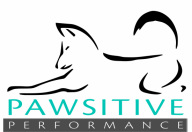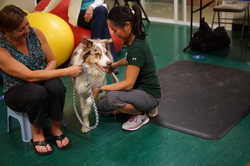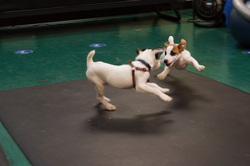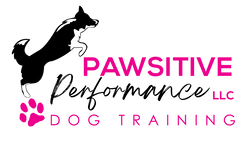 Recently I wrote about the team approach to K9 Fitness and how collaboration between professionals in the veterinary, rehabilitation and fitness fields are important. Because I refer clients regularly for diagnostics and diagnosis, I receive referrals from those professionals when no discernible problem exists, the dog is released to normal activity or a strength or training issue is discovered. A few months ago, a local veterinarian referred a dog and handler to me for strength and flexibility training. The dog was brought to their veterinary clinic due to poor performance on the agility course - knocking bars, occasionally popping out of weave poles and taking wider right turns especially over jumps. Upon palpation the veterinarian did not find anything remarkable and the owner did not seek further diagnostics because nothing was “broken.” The veterinarian referred the dog to me assuming it was a strength or training issue. When you know your dog is off, and your veterinarian can't find anything medically wrong, a good solution can often be strength and body awareness training so the dog can figure out how to best use his body. For purposes of this blog post, I will call the dog Bodi. Bodi is a five-year-old Border Collie. The owner came to me with the same complaints as listed above and unsure what to do or where to go. The dog is the handler’s beloved agility partner and the thought of not being able to continue training with this dog was overwhelming. We talked about progression of jump training, weaves and turns and I had the handler send me agility video of her dog from before and after the issues started. Based on the information provided, and my own personal agility training, it appeared that she had done all the correct training to achieve proper jumping, turning and weave pole movement necessary to compete in agility. However, there was a definite change in his performance. I also asked the handler if she, personally, had had any physical changes – such as a pulled muscle, tight muscles in her legs, injured toe, increased weight or anything else that would affect her movement. There was nothing that she could think of. There were also no noticeable changes in the handler when reviewing the agility videos. After touching Bodi from head to toe, and observing him move and perform a few exercises, I began to design a plan to improve weight distribution, coordination, flexibility and strength. My program is generally designed to help a dog use it’s body efficiently which typically results in improved performance. The owner was asked by the veterinarian to take a 4-week break from agility (just be safe) and perform very specific strength and flexibility exercises (suggested by me) three to four times a week. Daily, walks were recommended on leash for 30-40 minutes, with 10 minutes of off-leash time without other dogs to chase for the same 4-week period. After 4 weeks if symptoms did not return, Bodi was released to all normal activity and a gradual return to performance. I tend to apply a very cautious approach and ask my clients to spend a bit more time on strength and body awareness before returning to full activity just to make sure that we aren’t pushing too quickly. In this case, the handler and I met every three weeks, reviewed the previous exercise plan and Bodi’s progress then designed a new plan increasing the difficulty of the exercises and off-leash time. Each plan was emailed to the veterinarian for review and approval. After several weeks of fitness training, we worked together to design a plan for a gradual approach to full height agility jumps and obstacles, while continuing the strength and flexibility program. The goal was to progress to full agility courses without hesitation or return of symptoms. After a couple months of helping Bodi to understand his body, improve balance and flexibility, he returned to agility without knocked bars and with fast and efficient weave poles. We are still working on tighter right turns. Even with the wider turns, his yards per second improved and he took 1st place in jumpers and 2nd place in his standard run. Using a cautious approach to K9 Fitness, we worked together to improve body awareness, strength and weight distribution, which improved Bodi’s performance. To say we are both thrilled with his improvements would be an understatement. Bodi has since participated in several agility trials over several months without having his previous symptoms return. We continue to increase the difficulty of his fitness program and regularly work on his flexibility and turning power to the right. Bobbie Lyons, Cert CF Online classes enroll 9/9 at HERE K9FITbone for K9Fitness, K9 Cond II, Performance Dog and Rehab self guided classes.  There are so many facets to strength and body awareness training that it is important to use the “team” approach applying information from the dog owner, veterinarian, rehabilitation professionals, physical therapist and fitness instructors. It is important to recognize subtle changes in how the dog moves or performs exercises. As a Fitness Coach, I don't diagnose injury, but with a careful eye on the dog’s movement, it allows me to refer to a qualified professional. Who is the team:
Some situations where a referral is needed:
If a dog has been performing strength and body awareness exercise regularly and does happen to get injured performing their sport or chasing a ball, then dog is already trained to do exercises similar to those recommended by the rehabilitation practitioner. This speeds up recovery because the dog and the handler have an understanding of what is needed and they do not have to go through the initial learning process. A dog that has been performing fitness exercises has been exposed to different pieces of equipment and training any new exercises is much more efficient. Performing a proper evaluation and reviewing a medical history on each dog helps to address what exercises to perform and if a referral needed. The list below addresses key points to consider:
Each client receives a written lesson plan for their dog after each session, detailing how often to do each exercise, instruction for each exercise (including photos and video support) as well as observations or tips to work with the dog. A copy of this lesson plan is sent to the veterinarian or rehabilitation professional, if needed. These records are also saved in a client file for future reference. Perfect dogs for K9 Fitness
Referring clients to a qualified professional when needed improves communication with professionals in the field and fosters a “team” approach to K9 Fitness. Bobbie Lyons, Cert CF pawsitiveperformance@yahoo.com  Hmm my mind has been on "puppies" lately, not really sure why. LOL Teaching a puppy body awareness and weight distribution exercises at an early age helps the puppy grow into a confident, well balanced and coordinated dog. I start teaching my clients these types of exercises when their puppies are just 8 -12 weeks old. I adjust duration of exercise or repetitions to the age, ability and attention span of the puppy I am working with and I mix in PLAY as much as possible during the sessions. Body awareness programs for puppies teach them how to learn through shaping and luring. It will also increases the human/dog bond. Many exercises can be shaped as independent movements but some exercises require you to physically maneuver your dog to achieve the correct position. Handling all body parts of your puppy at an early age helps them to be more tolerant of it as they grow older. This is important for nail trimmings, grooming and trips to the vet. I focus on exercises that require balance and coordination but do not over stress the joints at an early age. I am slow and careful with puppies. Puppies get a lot of jumping, pivoting and multi-directional balance in everyday life -- as they run around the back yard and play with pack mates. When performing exercise with puppies, I carefully watch for movements that keep the knees in line with the hips as much as the puppy’s conformation allows. I also watch for good posture, top-line angles and head position. As previously mentioned in a earlier blog, I do not recommend multi-directional wobble boards or balance discs for sustained exercises for puppies because when puppies, and some older dogs, mount these pieces of equipment their rear legs spread wide which can put unnecessary pressure on the joints. My preference is to teach the puppy body awareness and coordination on the flat first. Once the dog can obtain the correct position on the flat, then I add unstable FitPAWS equipment such as rocker boards, peanuts, Fitbones, and paw pods that improve proper weight distribution while keeping the body in alignment. I suggest putting the donut holder under the wobble board which allows it to jiggle but not to rock. When the dog has well developed muscles and bones (at about age 12 months) then add sustained exercises on wobble boards and balance discs. I also like surface training a puppy with a deflated large balance discs put on top of the rocker board so you get unstable and a different surface. Other options would be the deflated Fitpaws balance disc on top of the peanuts, donut, and under caveletti poles. I feel it is very important to watch the amount of repetition done in any routine. Set a time limit and stick to it, and watch your puppy’s posture, topline angle, rear leg and head position to make sure you are encouraging good weight distribution, posture and alignment. Early Puppy Development: Please note: Putting balance discs, and wobble boards in whelping boxes for surface discrimination exposure is perfectly fine. The puppies generally are walking over or laying on these pieces if equipment, they are not doing sustained exercises or holding sustained positions. My concerns are for the puppy after arriving at its forever home. New puppy owners get over excited about having a puppy that they tend to start training tricks right away. Why not, there are so many options these days to help teach your puppy how to learn. Where the problem lies in the repetition involved in training new exercises and positions. We are human and we get excited and 15 min can go by quickly and the number of repetitions that can be done in 5-15 minutes is astounding. Bobbie Lyons, Cert CF Ph. 503-329-1235 Targeted Conditioning Programs for K9 Athletes: Private Lessons, Online Classes, & Workshops Online Classroom Website (NOTE: enrollment 9/9/2014 –New classes will be offered): http://classroom.daisypeel.com/k9-conditioning-rehab-classes/ Website: http://www.pawsitive-performance.com/ |
AuthorBobbie Lyons, CCFT, KPA CPT Archives
April 2019
Categories |

 RSS Feed
RSS Feed